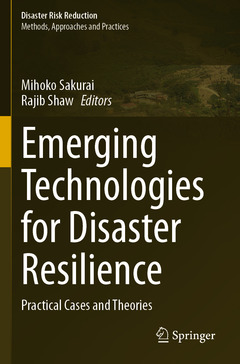Description
Emerging Technologies for Disaster Resilience, 1st ed. 2021
Practical Cases and Theories
Disaster Risk Reduction Series
Coordinators: Sakurai Mihoko, Shaw Rajib
Language: English
Subject for Emerging Technologies for Disaster Resilience:
Publication date: 05-2022
260 p. · 15.5x23.5 cm · Paperback
Publication date: 05-2021
Support: Print on demand
Description
/li>Contents
/li>Biography
/li>Comment
/li>
Technological advances have helped to enhance disaster resilience through better risk reduction, response, mitigation, rehabilitation and reconstruction. In former times, it was local and traditional knowledge that was mainly relied upon for disaster risk reduction. Much of this local knowledge is still valid in today?s world, even though possibly in different forms and contexts, and local knowledge remains a shared part of life within the communities. In contrast, with the advent of science and technology, scientists and engineers have become owners of advanced technologies, which have contributed significantly to reducing disaster risks across the globe.
This book analyses emerging technologies and their effects in enhancing disaster resilience. It also evaluates the gaps, challenges, capacities required and the way forward for future disaster management. A wide variety of technologies are addressed, focusing specifically on new technologies such as cyber physical systems, geotechnology, drone, and virtual reality (VR)/ augmented reality (AR). Other sets of emerging advanced technologies including an early warning system and a decision support system are also reported on. Moreover, the book provides a variety of discussions regarding information management, communication, and community resilience at the time of a disaster. This book?s coverage of different aspects of new technologies makes it a valuable resource for students, researchers, academics, policymakers, and development practitioners.Mihoko Sakurai is an associate professor at the International University of Japan, Center for Global Communications. Her academic background is in information systems and policy design. She has studied effective ways of using information communication technology in Japan's municipal governments. After the devastating Great East Japan Earthquake in 2011, she conducted field research and designed information systems to enhance the handling of future and unexpected disasters, especially for municipalities that have to deliver disaster relief to their residents. Her work related to the 2011 earthquake won the Best Paper Award at the International Telecommunication Union (ITU) Kaleidoscope Conference (2013) and the Hawaii International Conference on System Sciences (HICSS) (2016). Currently she is organising a research project discussing ICT use, disaster management and resilience with Japanese local councils and private enterprises. Her work has been published in the International Journal of Disaster Risk Reduction, European Journal of Information Systems,IEEE Communications Magazine, International Journal of Information Systems for Crisis Response and Management, Communications of the Association for Information Systems, Sustainable Cities and Society and in the proceedings of the leading international conferences.
Rajib Shaw is a professor in the Graduate School of Media and Governance of Keio University, Japan. He is also a senior fellow of the Institute of Global Environmental Strategies (IGES) Japan, and the chairperson of the Sustainable Environment and Ecological Development Society (SEEDS) Asia and the Church World Service (CWS) Japan, two Japanese NGOs. He is the co-founder of a Delhi-based social entrepreneur startup, Resilience Innovation Knowledge Academy (RIKA). Earlier, he was the executive director of Integrated Research on Disaster Risk (IRDR) and was a professor at Kyoto Univers
Introduces state-of-the-art technologies and their application to disaster risk reduction
Provides a holistic perspective of disaster risk reduction including communication and decision support
Discusses the interdisciplinary framework and insight for the field of technologies and disaster risk reduction
Suggests implications for policies used in disaster technologies in the context of disaster risk reduction




